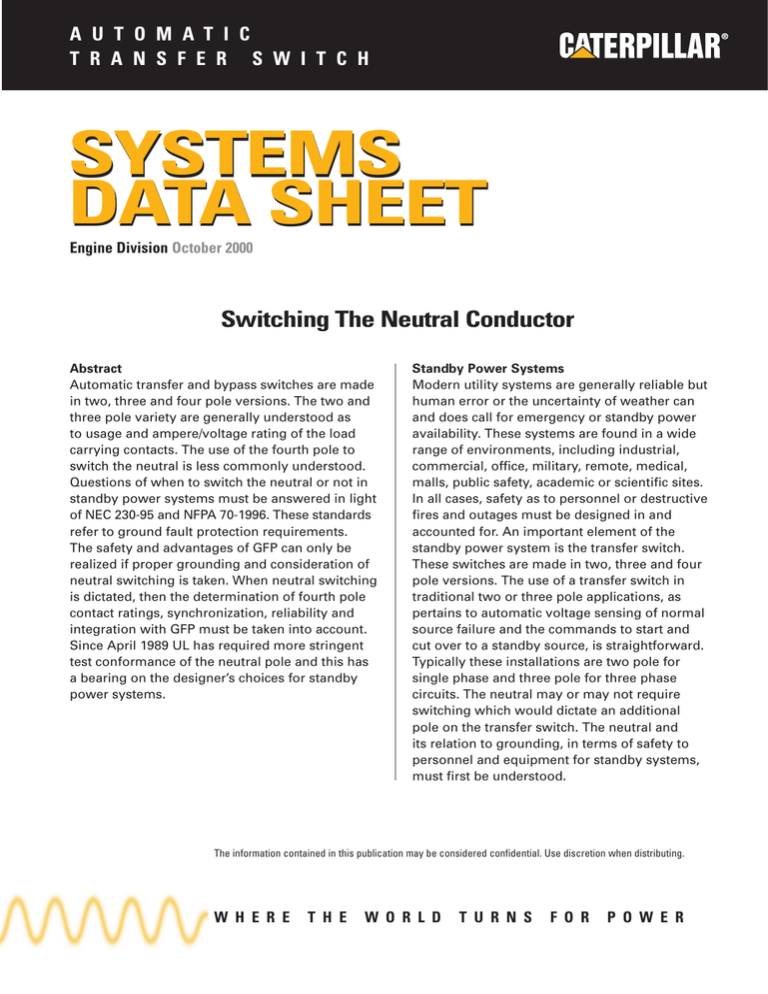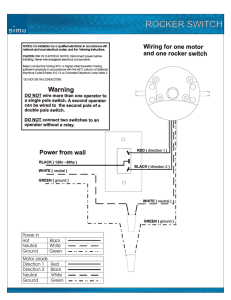
A U T O M A T I C
T R A N S F E R S W I T C H
SYSTEMS
DATA SHEET
Engine Division October 2000
Switching The Neutral Conductor
Abstract
Automatic transfer and bypass switches are made
in two, three and four pole versions. The two and
three pole variety are generally understood as
to usage and ampere/voltage rating of the load
carrying contacts. The use of the fourth pole to
switch the neutral is less commonly understood.
Questions of when to switch the neutral or not in
standby power systems must be answered in light
of NEC 230-95 and NFPA 70-1996. These standards
refer to ground fault protection requirements.
The safety and advantages of GFP can only be
realized if proper grounding and consideration of
neutral switching is taken. When neutral switching
is dictated, then the determination of fourth pole
contact ratings, synchronization, reliability and
integration with GFP must be taken into account.
Since April 1989 UL has required more stringent
test conformance of the neutral pole and this has
a bearing on the designer’s choices for standby
power systems.
Standby Power Systems
Modern utility systems are generally reliable but
human error or the uncertainty of weather can
and does call for emergency or standby power
availability. These systems are found in a wide
range of environments, including industrial,
commercial, office, military, remote, medical,
malls, public safety, academic or scientific sites.
In all cases, safety as to personnel or destructive
fires and outages must be designed in and
accounted for. An important element of the
standby power system is the transfer switch.
These switches are made in two, three and four
pole versions. The use of a transfer switch in
traditional two or three pole applications, as
pertains to automatic voltage sensing of normal
source failure and the commands to start and
cut over to a standby source, is straightforward.
Typically these installations are two pole for
single phase and three pole for three phase
circuits. The neutral may or may not require
switching which would dictate an additional
pole on the transfer switch. The neutral and
its relation to grounding, in terms of safety to
personnel and equipment for standby systems,
must first be understood.
The information contained in this publication may be considered confidential. Use discretion when distributing.
W H E R E
T H E
W O R L D
T U R N S
F O R
P O W E R
AUTOMATIC TRANSFER SWITCH
Grounded vs. Ungrounded Neutrals
NEC differentiates between system and
equipment grounding as follows:
An ungrounded system features no intentional
connection between the system conductors and
ground. What is easily forgotten though is the
capacitive coupling that always exists between
system conductors and ground. See Fig. 4.
Because of the danger to personnel and possible
damage to equipment and property, should there
be leakage to ground due to shorts or high
impedance paths, the NEC decrees that certain
grounding practices and detection of these faults
be designed into systems.
System Ground: A system ground is a connection
to ground from one of the current-carrying
conductors of a distribution circuit or of an
interior wiring scheme. See Fig. 1.
Equipment Ground: An equipment ground is a
connection to ground from one or more of the
non-current-carrying metal parts of the wiring
system or of apparatus connected to the system.
As used in this sense, the term equipment
includes all such metal parts as metal conduits,
metal raceway, metal armor of cables, outlet
boxes, cabinets, switch boxes, motor frames and
metal enclosures of motor controllers. See Fig. 2.
The utilities generally provide power to large
users via three phase grounded wye distribution.
The power transformer feeding the user will have
its neutral grounded. For a system having a
neutral conductor that is not grounded, the
possibility of destructive transient voltages
appearing from line to ground during switching of
a circuit having a line to ground fault is very likely.
See Fig. 5. In addition, an ungrounded neutral
system developing a fault to ground may go
unnoticed until a second ground fault causes a
line to line fault which can be of major proportions.
See Fig. 6. These ungrounded systems are
designed into critical industrial processes that
cannot afford tripping of protective devices
should a ground fault develop. Such a condition
could shut down operations or parts of process
that could result in explosion or loss of product
being processed.
System Neutral Ground: A system neutral ground
is a connection to ground from the neutral point
or points of a circuit, transformer, rotating
machine or system. The neutral point of a system
is that point which has the same potential as the
point of junction of a group of equal nonreactive
resistances if connected at their free ends to the
appropriate main terminals or lines of the system.
See Fig. 3.
Fig. 1
System Ground on an
Ungrounded System
Fig. 2
Equipment Ground Ungrounded Neutral
2
Fig. 3
System Neutral Ground
1st GND. FAULT
2nd FAULT
Fig. 4
Ungrounded System
Capacitively Coupled
to Ground
Fig. 5
Transient Overvoltages Due to Ground Fault
Interruption on Ungrounded system
May Cause Other Faults to Occur on System
A system featuring neutral grounding has many
advantages over the ungrounded system. That is:
•
•
•
•
•
PATH OF FAULT CURRENT
Fig. 6
Ungrounded Neutral System
Developing Second Fault to Ground
Ground fault protection equipment is designed to
detect phase to ground faults ignoring overloads
and phase to phase faults. Three methods of
detection are employed:
Greater safety for personnel and equipment
Increased service reliability
Lower operating and maintenance expense
Reduced magnitude transients
Simplified ground-fault location
•
•
The NEC requires that ground fault protection
must be used for all solidly grounded wye services.
This requirement first appeared in the NEC in
1971 (230-95). It stated, “Ground fault protection
of equipment shall be provided for solidly
grounded wye electrical services of more than
150 volts to ground, but not exceeding 600 volts
phase to phase for each service disconnecting
means rated 1000 amperes or more.” See Fig. 7.
•
The reason behind this requirement was an
awareness that sustained arcing on grounded
480Y/277 volt systems could be very damaging.
The selection of 1000 amperes or more for ground
fault protection was made with the belief that
smaller overcurrent devices with long trip times
of 1000 amperes or less would probably clear an
arcing ground fault in sufficient time to limit
damage. A designer could under this rule,
choose as many as six 800 amperes mains in a
480Y/277 volt switchboard (4800 amps of service)
without having to install ground fault protection.
Zero Sequence, detects vector unbalance of
current sum in each phase and the neutral.
Outputs if not zero.
Residual Connected, uses 3 or 4 CT’s and
4 time relays. Any leakage to ground will
output a signal.
Source Ground, detects current flow through
system grounding conductor which is
connected between neutral and ground.
Fig. 7
Source Featuring Grounded Neutral at Transformer and
Service Entrance with GFP Sensor
3
Switching the Neutral Conductor
None of these methods are totally without
problems. Proper operation requires that
detection will monitor all fault currents to ground.
Should there be multiple grounding of the neutral
it is possible that proper operation of the GFP
device will not monitor the total fault. See Fig. 8.
Therefore, it is important to insure that grounding
of the neutral not take place at multiple locations
so as to create unintended paths and defeat
the GFP sensor. The NEC further limits neutral
grounding via the “separately derived system”
rule. That is, a system source such as a
transformer or a generator can have its neutral
grounded at only one place. The correct place
to ground the service neutral is at the main
panelboard or switchboard. It is not permitted
to be grounded at other points.
Standby Power Systems
A correctly grounded standby generator system
including the transfer switch is shown in Fig. 9.
Note that a three pole transfer switch is used and
the gen set does not have its neutral grounded at
the generator although the housing is grounded.
Should a fault develop to ground only one path
exists and the GFP sensor would signal the
unbalance. Since the neutral is common to both
the normal and standby sources, the generator
is not considered separately derived. Under this
scheme the neutral is not grounded at the housing.
Fig 10 depicts the division of current that would
occur in the event of a ground fault. Some portion
would return outside the GFP sensor. Yet another
problem with a generator neutral ground is
shown in Fig. 11. In this case the neutral current
can divide and return via the gen set ground path.
This also will fool the GFP sensor into monitoring
less fault current than may be flowing.
Fig. 8
Multiple Grounding of Neutral Allows Fault Current
to Flow Back Through Neutral Via Paths A & B
(Flow via C is outside GFP Sensor)
FROM UTILITY
GFP
Fig. 10
Generator Set Grounded to Neutral at Housing Neutral
Bus Isolated from Housing of Transfer Switch
STANDBY POWER SOURCE
A
B
B
C
THREE
POLE
TRANSFER
SWITCH
CKT.
BKR.
A
N
C
N
GND.
GEN.
SET
BOND TO
HOUSING
G N
C B A
Fig. 9
Correctly Grounded Standby Power Source
Fig. 11
Neutral Current Returning on Ground
(Partial Current Outside GFP)
4
Switching the Neutral Conductor
In all the above cases the three pole transfer
switch must have contact structures that are able
to withstand the fault currents for the time that is
taken before sensing and the protective devices
clear the circuit. Transfer switches that are
properly designed will have relatively high
withstand and close into fault current values for
this demanding work. Also in the above cases
the neutral current carrying line was solidly
connected and not switched.
A designer has the tools to now configure a
standby system as either separately derived or
not. If the system needs are for not grounding the
gen set at its site then a three pole transfer switch
with a solid neutral should be employed. If the
gen set needs to be grounded at its site, then a
four pole transfer switch must be designed into
the system. This will insure that the neutral is
switched isolating the normal or utility supply.
Lastly, should the designer decide to switch the
neutral, consideration to contact ratings and
performance should be taken into account.
Should the designer want to ground the generator
and still adhere to code and avoid the problems
of split return paths and improper GFP sensing
the use of a four pole transfer switch is called for.
Fourth Pole and UL Requirements
As of April 1989, UL 1008 required that the fourth
pole of a transfer switch be tested and proven to
have ratings equal to its phase contacts if not of
the same construction. And that bus spacing is
closer to line than its line to line spacing or it has
a different means of support for its neutral bus.
That means that the neutral contact must be
capable of withstand and close into fault ratings
at least equal to the phase contacts. The fact is,
not all transfer switches employing a fourth pole
are constructed in like fashion.
Four Pole Transfer Switches
Four pole switches are employed to insure
that the generator can be grounded without
compromising the NEC. That is, the gen set
can be wired as a separately derived system by
grounding the neutral at the gen set as long as
the neutral is no longer solid through the transfer
switch. This of course infers that neutral be
switched at the same time as the phases.
This scheme will also insure GFP operation as
intended. Fig. 12 shows a four pole transfer switch
wired with a gen set having its neutral grounded
at the housing. In this wiring the neutral return
path is deliberately open for ground return currents
by the transfer switch contacts. This will also avoid
nuisance tripping in the case of an unbalanced
load. In effect, the gen set is now completely
isolated from the utility service and presents an
effective and safe alternative to solid neutral lines.
There exist four pole switches that utilize contacts:
•
•
•
of different amperage (lower) capacity than
the phases
that do not actuate by the same means as
the phase contacts
that have bus supports differing from the
phase supports
Fig. 12
Use of 4 Pole Transfer Switch to Permit Grounding of Generator Set at Site
5
•
•
that have bus structures with closer spacing
than phase to phase spacing
that have synchronizing characteristics differing
from phase contact make-break timing
Since all transfer switches must comply with and
meet the requirements for UL 1008, a designer
must examine the ratings and specifications of
a four pole transfer switch should the system call
for switching the neutral.
At a minimum the designer should insure that
all four poles are equally rated as to carrying,
withstand, close into fault currents and voltage.
The designer should also ascertain that bus
supports, spacings and actuating means are
identical for all contacts. The aspect of actuating
means can be critical.
If all contacts are actuated by a common shaft,
there can be no question of a neutral never having
been switched while the phases were. There are
switches that have fourth pole contacts actuated
by means other than the main phase contact
shaft. Interesting results are obtained by
transferring the phases to standby power and
leaving the neutral connected to the normal
power source. There exists some debate over
synchronizing the timing of the fourth pole.
For those transfer switches having all contacts
actuated by a common shaft, the neutral will swing
in harmony with the phase contacts. In fact, if the
neutral leads the phase contacts by an amount to
insure make first, break last, then the possibility of
transient voltages during switching is diminished
or eliminated. For those switches employing a
separate actuating means for the neutral, the
possibility of timing differences are much greater.
These switches employ the overlapping contact
arrangement which adds to complexity. Four pole
transfer switches with common shafts change
position rapidly enough to minimize any currents
due to transients.
LEXX0604
Although the subject of another discussion, the
more recent attention to third harmonic current
appearing on the neutral and its attendant
emphasis on having greater contact capability,
the need for reliable fourth pole operation is
even more pronounced.
Summary
While the system designer has the option of
selecting two, three and four pole transfer
switches for standby power systems, the choice
of ground vs. ungrounded systems is one of safety
and code. The NEC requires systems of particular
capabilities to incorporate ground fault protection.
If GFP is employed, then consideration of
appropriate grounding and neutral switching is
warranted. Complications and errors can be
avoided in grounded systems employing GFP by
utilizing four pole transfer switches. These switches
must be selected on the basis of the fourth pole
ratings, actuation and synchronization.
UL 1008 now mandates that the four pole transfer
switch will have its neutral pole contact meet
testing identical to its phase contacts. Recent
emphasis by designers is to insure fourth pole
integrity by specifying an equal to current rating.
Therefore three or four pole transfer switching
is available to solve the problem at hand.
References
ANSI/NFPA 70 – 1996 National Electric Code
Nash, Hugh O. Jr, “Ground Fault Protection and
the Problem of Nuisance Tripping of Critical
Feeders” IEEE CH2581-7/88
D. Beeman, “Industrial Power Systems
Handbook” McGraw-Hill, 1955
A. Freund, “Double the Neutral and Derate the
Transformer – Or Else!” E C & M, Dec. 1988
© 2000 Caterpillar
Printed in USA
All rights reserved.



